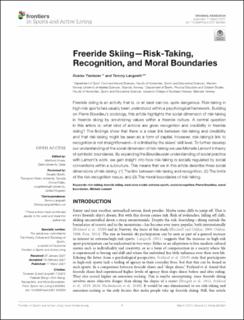Freeride Skiing—Risk-Taking, Recognition, and Moral Boundaries
Peer reviewed, Journal article
Published version
Permanent lenke
https://hdl.handle.net/11250/2839496Utgivelsesdato
2021Metadata
Vis full innførselSamlinger
Originalversjon
Tøstesen, G. & Langseth, T. (2021). Freeride Skiing—Risk-Taking, Recognition, and Moral Boundaries. Frontiers in Sports and Active Living, 3, Artikkel 650564. https://doi.org/10.3389/fspor.2021.650564Sammendrag
Freeride skiing is an activity that is, or at least can be, quite dangerous. Risk-taking in high-risk sports has usually been understood within a psychological framework. Building on Pierre Bourdieu's sociology, this article highlights the social dimension of risk-taking in freeride skiing by scrutinizing values within a freeride culture. A central question in this article is: what kind of actions are given recognition and credibility in freeride skiing? The findings show that there is a clear link between risk-taking and credibility and that risk-taking might be seen as a form of capital. However, risk-taking's link to recognition is not straightforward—it is limited by the skiers' skill level. To further develop our understanding of the social dimension of risk-taking we use Michelle Lamont's theory of symbolic boundaries. By expanding the Bourdieusian understanding of social practice with Lamont's work, we gain insight into how risk-taking is socially regulated by social conventions within a subculture. This means that we in this article describe three social dimensions of risk-taking: (1) The link between risk-taking and recognition, (2) The limits of the risk-recognition nexus, and (3) The moral boundaries of risk-taking.

